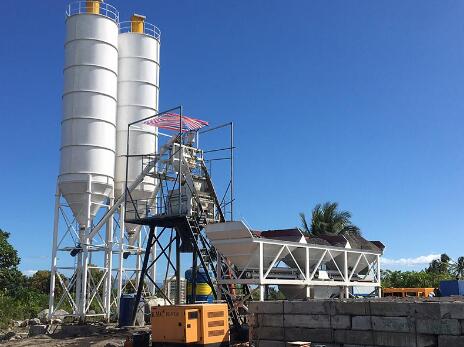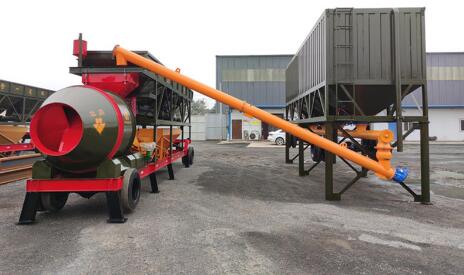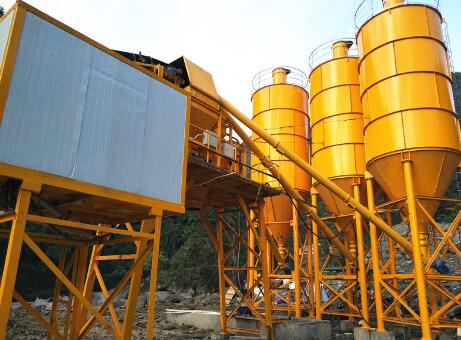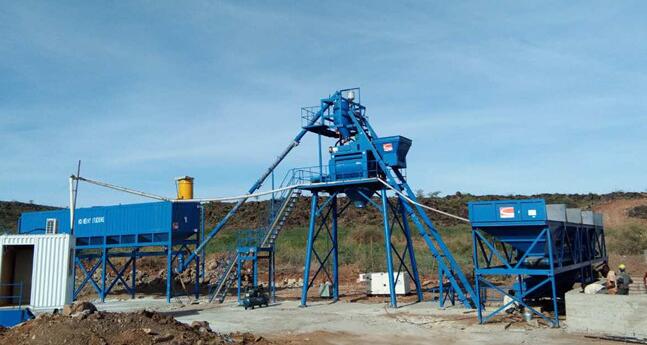Types of concrete batching plant
A concrete batching plant is equipment that mixes various ingredients to make concrete. These materials include water, air, aggregates, cement and fly ash. A batching plant consists of a variety of parts and machines: mixer unit, conveyors, aggregate and cement batchers, cement silos etc. Once the quality concrete is prepared it is transported to the site on a truck with a revolving drum which is known as a transit mixer. The concrete produced out of the concrete batching plant is used in the foundations of building construction. Concrete batching plants are divided into different types according to different classification criteria. Depending on the construction project, the type of material used to create the concrete can differ. This is a basic classification that many manufacturers distinguish at the time of production. Concrete batching equipment is designated as Manual, Semi-Automatic, and Automatic.
In the construction industry, the efficiency and precision of material preparation are crucial for project success. Batching equipment, such as concrete batching systems, plays a pivotal role in this process by accurately measuring and mixing the components needed for concrete. These systems, ranging from simple to highly automated concrete batching equipment, ensure that each batch is consistent, which is essential for maintaining the quality and strength of structures. By investing in advanced concrete batching solutions, construction companies can significantly improve their productivity while reducing waste and costs.
The batching plant is one of the most important pieces of equipment in the construction industry. The concrete plant has many important components which include the cement and aggregate batchers, aggregate bins, conveyors, mixers, heaters, cement silos, control panels and dust collectors. The efficiency of the batching plant is more important to get high-quality and durable concrete. The growth of the segment is led by growing customer preference for high capacity and technologically advanced batching plants. Factors such as the increasing number of construction projects, shorter completion time, and demand for customised solutions by end-users are further fuelling the growth of this segment. Discussed below are different types of concrete batching plants used across projects.
Different concrete batching plant types
Stationary concrete batching plant
In the Stationary Concrete Batching Plants cement is mainly applied as a binding material for mixing sand, water, and aggregates and major additives as well to produce concrete in a fast manner for the civil construction projects. The gathering conveyor belt runs below the bins where weighing of aggregates takes place and the aggregate are then discharged onto the charging conveyor. Pneumatically operated gates are provided for discharge of the aggregate on to the gathering conveyor. The material is all weighed accurately and transferred to the twin shaft mixer through a slinger conveyor. These stationary concrete plant pneumatics used are of reputed make which ensure long life and superior performance for your machine. The Stationary Plants are available in various capacities ranging from 30 m3 to 240 m3 per hour of compacted concrete output. In the current Stationary concrete plants, the aggregates are stored in horizontal bins. The gathering conveyor belt runs below the bins where the weighing of aggregates takes place and the aggregates are then discharged onto the charging conveyor. Pneumatically operated gates are provided for discharge of the aggregate onto the gathering conveyor. The material is all weighed accurately and transferred to the twin shaft mixer through a slinger conveyor. The new batching plants also come with the Skip Hoist and Belt arrangement option for mixer loading. The news models can adopt silica dosing and some special additives very easily.

Stationary concrete batching plant
Mobile concrete batching plant
Mobile plants consisting of portable shaft mixers are designed to be moveable and thus are installed on towable chassis with wheels for maximum mobility and quick setup. Mobile batching plants are perfect for temporary construction sites or construction projects where the equipment would only be needed for specific and brief portions of the projects. Mobile concrete equipment can be easily installed and dismantled and as such require very minimal preparation or set up before use. Mobile concrete batching plants come pre-wired with maximum equipment installed to ensure fast installation on site. Typically a standard mobile plant can be installed in 1-2 days. There has also been the development of Containerized concrete batching plants recently. The containerized concrete batch plant is a new type of batching plant. It consists of a mixing system, control system, material storage system, weighing system, conveying system and others. Also, the container mixing plant owns the features such as small footprint, quick installation, convenient transportation and so on. Compared with the traditional concrete plant, the container mixing plant does not need to set the legs and mounting brackets, eliminating basic design and construction.

Mobile concrete batching plant
Wet mix concrete batching plant
Modern wet batching concrete plants combine all the ingredients required to make concrete before it’s moved to the mixing trucks. Central-mix batching plants utilise plant-mounted mixers where you place all the concrete ingredients. Latest-model adopts a twin shaft paddle mixer, which has a strong mixing quality. This can ensure there is no or less residual in the twin shaft concrete mixer, save materials and save cost. With a Central Mix plant, all loads see the same mixing action and there is an initial quality control point when discharging from the central mixer. Wet mix plants are accessible in versatile and stationary models. The best mechanical design worked into the item seeks for uniform mixing without detachment, correct proportioning and blending of aggregates and included substances. The wet mix plant conveys precisely mixed cold mix, emulsion treated mixes etc.
Transit/ Dry mix concrete batching plant
Modern-day dry mix concrete plant consists of the cement silos, feeding system, control system, weighing system and mixing system. Cement silos are the container to keep and supply raw materials such as cement, sand, and fly ash according to the necessity of the production. The feeding system is a bridge to connect the aggregates and the mixing system. The accuracy of the weighing system determines the quantity of the mixed materials, so it has a great effect on the quality of mixed concrete. Dry mix concrete batching plants only weigh all the materials as per concrete formula, and then discharge them into concrete mixer trucks. The process of mixing all materials is done in a concrete mixer truck. Throughout the process, a concrete mixer truck is responsible for both transportation and mixing. Dry mix concrete batching plant does not have the mixing system as the one “wet mix” concrete batching plant possesses. Therefore, the dry mix concrete batching plant overcomes some inherent defects of the “wet mix” concrete batching plant has, which is not only suitable for the working conditions of the wet mix concrete batching plant, but also for extreme conditions such as high temperature, high heat, high altitude and long transportation distance etc.

Transit/ Dry mix concrete batching plant
Compact concrete batching plant
Compact Concrete Batching Plants are made up of smaller units of pre-designed or pre-wired production equipment that are often transported in batches to be finally assembled at the site they are to be used. This ensures that transportation is both faster and easier. This compact design ensures that the compact concrete plant combines some of the mobility advantages of the mobile batching plants and the performance prowess of the stationary concrete batching plant. Compact concrete plant is designed to minimise work on site during installation and is plumbed and tested at the manufacturing facilities. This type of plant mainly transport the ingredients smartly and also reduce the pollution factors emission.
Horizontal concrete batching plant
Horizontal concrete batching plant series has a simple but robust design. The assemblies are optimised for cost-effective transport and quick assembly. A modern and easy-to-operate control system rounds off the attractive overall package. A wide variety of concrete recipes are produced reliably and in high quality. The plant is equipped with a powerful ring-pan mixer and produces up to 69 m³ of fresh concrete per hour. Depending on the requirements, the newer model series is equipped with a pan mixer or a twin-shaft mixer. While designing the plant, high importance was attached to the access thereby facilitating maintenance. In addition, the generously dimensioned space allows this plant to be offered in a wide variety which can be taken from a modular system. These high capacity, heavy-duty plants are the first choice wherever large quantities of concrete are required.

Horizontal concrete batching plant
Inline concrete batching plant
New generation inline concrete batching plant integrated with advanced PLC technology automation that allows to perform functionalities like high speed weighing, automatic scale tolerance checking, inventory monitoring, reports generation including batch wise, load wise, data wise, recipe wise and production wise reports for a better and cost effective concrete manufacturing process. The newly designed Twin shaft mixer and Planetary Mixer enables efficient mixing of concrete with less wastage and improved quality parameters with concrete mixing plant. This is a proficient concrete production unit which is designed to give optimum mixing performance while reducing the operation and production costs with lesser maintenance required.
Containerized concrete batching plant
The containerized concrete batch plant consists of mixing system, control system, material storage system, weighing system, conveying system and others. In addition, the container mixing plant owns the features such as small footprint, quick installation, convenient transportation and so on. Compared with the traditional concrete plant, the container mixing plant does not need to set the legs and mounting brackets, eliminating basic design and construction. The container concrete batching plant has excellent environmental performance, convenient transportation and simple installation. It is suitable for supplying concrete production of various types such as hydropower, highways, ports, airports, bridges and other construction projects, as well as the construction of commercial concrete batching plants.
Conclusion
Based on value, the batching plant segment is one of the largest segments in the concrete equipment market. The growth of the segment is led by growing customer preference for high capacity and technologically advanced batching plants. Moreover, factors such as the increasing number of construction projects, shorter completion time, and the demand for customized solutions by end-users are further fuelling the growth of this segment.













